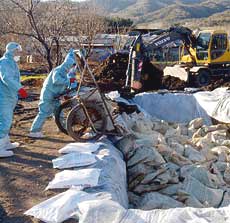“The extent of this (avian flu) outbreak is unprecedented.”
-World Health Organization

January 29, 2004 London, England – The World Health Organization’s Director of the Influenza Collaborating Centre, Alan Hay, said this week, “The extent of this (avian flu) outbreak is unprecedented.” It is also virulent and jumping from birds to humans. The big medical fear is: What happens if the avian virus begins jumping from human to human? How fast and far could it spread? The worry is warranted. SARS in 2003 was also a virus that jumped from animals to humans and began spreading and killing rapidly.
On this date, Health Canada‘s public health reporter, Andre Picard, wrote:
“If avian flu becomes pandemic, as many public-health officials fear, it could kill as many as 58,000 people in Canada alone. As part of a detailed pandemic preparedness plan, epidemiologists estimate that a new strain of influenza, such as one that jumps from birds to humans, could kill 11,000 to 58,000 Canadians in a matter of weeks.
“Those hardest hit would likely be young children and the old, whose immune systems are least able to fight off infection. The disease could also put 35,000 to 138,000 people in hospital and leave between 4.5 million and 10.6 million others too sick to work, which could have a devastating economic impact.”
Dr. Alan Hay in London and his W.H.O. colleagues in Geneva are warning that the number of domestic birds that now must be eliminated to control the epidemic of avian influenza spreading through Asia will be the largest on record. Ten people have died so far in the virus jump from birds into humans. Those deaths were in Vietnam and Thailand.
China became the tenth nation to confirm that the avian virus, known medically as H5N1, has infected its bird population. That was in a duck farm in Guan-gi province. This is a major blow after the SARS outbreak last year. Chicken is a staple meat for China’s 1.3 billion people and China is the third largest supplier of chicken to Japan. However, Japan immediately banned Chinese chicken imports until the avian flu can be stopped.
Chinese officials called for a quarantine around the duck farm in Dingdang where 14,000 birds were killed. Other farms within three miles of the duck farm were also quarantined. The official news agency, Xin-hua, reported:“Local governments have made necessary measures of slaughter or quarantine to prevent a spread. No people have been found infected so far and the epidemic has been in control.”
But until the Chinese government knows how and where the ducks were infected, it won’t have a firm control on the deadly disease’s spread. Animal smuggling for profit is a big business in Asia and no one, so far, has an answer about how to detect and stop the illegal trades that could involve virus-infected birds, civets and other creatures.
-
More Information:
W.H.O. warned this month that avian influenza, or bird flu, could be a more serious health problem this year than what happened with SARS in 2003.
W.H.O. Questions and Answers:
Are the avian flu and SARS related?
No. SARS is caused by a coronavirus, similar to one of the types of virus that causes the common cold. Avian flu is caused by an influenza virus. However, the source of both the SARS coronavirus and the influenza viruses were animals and the viruses “jumped” into humans.
What are the symptoms?
Fever, fatigue, cough and sore throat.
How does avian flu spread?
Human contact with the droppings of infected birds. In two Hong Kong outbreaks, investigators found poor sanitation and slaughtering practices at outdoor poultry markets close to housing areas.
Where did avian flu come from?
Wild birds are affected by a large number of flu viruses, just as humans and other animals are, but avian flu has usually remained in the bird population. The first case of a person dying from avian flu was reported in Hong Kong in May 1997. Prior to that case, avian influenza in humans usually caused only mild symptoms such as pink eye. That means the virus has mutated some how to become more virulent now. So far, three subtypes of the influenza A virus H5N1, H9N2 and H7N7 have jumped the species barrier between birds and humans.
-
Website:
- http://www.who.int/en/
© 1998 - 2024 by Linda Moulton Howe.
All Rights Reserved.

